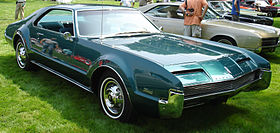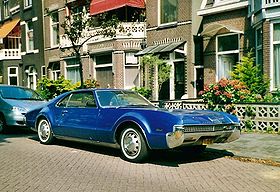Oldsmobile Toronado
| Oldsmobile Toronado | |
|---|---|

1966 Oldsmobile Toronado
|
|
| Overview | |
| Manufacturer | Oldsmobile (General Motors) |
| Production | 1965–1992 |
| Model years | 1966–1992 |
| Assembly | Lansing, Michigan, U.S. |
| Body and chassis | |
| Class | Full-size personal luxury car |
| Body style | 2-door coupe |
| Platform | E-body |
| Related |
Cadillac Eldorado Buick Riviera |
| First generation | |
|---|---|

1967 Oldsmobile Toronado
|
|
| Overview | |
| Production | 1965–1970 |
| Model years | 1966–1970 |
| Layout | Longitudinal front-engine, front-wheel drive |
| Powertrain | |
| Engine | 425 cu in (7.0 L) 385 hp (287 kW) Rocket V8 455 cu in (7.5 L) Rocket V8 |
| Transmission | 3-speed TH-425 automatic |
| Dimensions | |
| Wheelbase | 119.0 in (3,023 mm) |
| Length | 211 in (5,359 mm) (1966–67) 211.6 in (5,375 mm) (1968) 214.8 in (5,456 mm) (1969–1970) |
| Width | 78.5 in (1,994 mm) |
| Height | 52.8 in (1,341 mm) |
| Curb weight | 4,496 lb (2,039 kg) |
| Second generation | |
|---|---|

1973 Oldsmobile Toronado Custom
|
|
| Overview | |
| Production | 1970–1978 |
| Model years | 1971–1978 |
| Layout | Longitudinal front-engine, front-wheel drive |
| Powertrain | |
| Engine | 455 cu in (7.5 L) Rocket V8 403 cu in (6.6 L) Oldsmobile V8 |
| Transmission | 3-speed TH-425 automatic |
| Dimensions | |
| Wheelbase | 122 in (3,099 mm) |
| Length | 219.9 in (5,585 mm) |
| Width | 79.8 in (2,027 mm) |
| Height | 54.7 in (1,389 mm) |
| Third generation | |
|---|---|
 |
|
| Overview | |
| Production | 1978–1985 |
| Model years | 1979–1985 |
| Layout | Longitudinal front-engine, front-wheel drive |
| Powertrain | |
| Engine | 252 cu in (4.1 L) Buick V6 307 cu in (5.0 L) Oldsmobile V8 350 cu in (5.7 L) Oldsmobile V8 350 cu in (5.7 L) Oldsmobile diesel V8 |
| Transmission | 3-speed TH325 automatic 4-speed TH325-4L automatic |
| Dimensions | |
| Wheelbase | 114 in (2,896 mm) |
| Length | 204 in (5,182 mm) |
| Width | 80 in (2,032 mm) |
| Fourth generation | |
|---|---|
 |
|
| Overview | |
| Production | 1985–1992 |
| Model years | 1986–1992 |
| Layout | Transverse front-engine, front-wheel drive |
| Powertrain | |
| Engine | 231 cu in (3.8 L) Buick V6 3.8 L Buick 3800 V6 |
| Transmission | 4-speed 4T60 automatic 4-speed 4T60-E automatic |
| Dimensions | |
| Wheelbase | 108 in |
| Length | 1989–1992: 200.3 in (5,088 mm) 1986–88: 187.5 in (4,762 mm) |
| Width | 1989–1992: 72.8 in (1,849 mm) 1986–88: 70.8 in (1,798 mm) |
| Height | 1989–1992: 53.3 in (1,354 mm) 1986–88: 53 in (1,346 mm) |
The Oldsmobile Toronado is a personal luxury car produced by the Oldsmobile division of General Motors from 1966 to 1992. Designed to compete with the Ford Thunderbird and GM's own Buick Riviera, the Toronado is historically significant as the first U.S.-produced front-wheel drive automobile since the demise of the Cord in 1937.
The Toronado placed third in the 1966 European Car of the Year contest, a distinction no other American car has achieved before or since, and won the 1966 Motor Trend Car of the Year award in the U.S.
It used the GM E platform introduced by the rear-wheel drive Riviera in 1963 and adopted a year later with the front-wheel drive Cadillac Eldorado. Although each had quite different styling, the threesome shared the E platform for most of the Toronado's 28-year history.
The original Toronado began as a design painting by Oldsmobile stylist David North in 1962. His design, dubbed the "Flame Red Car", was for a compact sports/personal car never intended for production. A few weeks after the design was finished, however, Oldsmobile division was informed it would be permitted to build a personal car in the Riviera/Thunderbird class for the 1966 model year, and North's design was selected. For production economy, the still-unnamed car was to share the so-called E-body shell with the redesigned 1966 Buick Riviera, which was substantially bigger than North had envisioned. Despite the efforts of Oldsmobile and General Motors styling chief Bill Mitchell to put the car on the smaller A-body intermediate, they were overruled for cost reasons.
Oldsmobile had been working on front-wheel drive since 1958, a project shepherded by engineer John Beltz (who originated the 4-4-2 and would later become head of the division). Although initially envisioned for the smaller F-85 line, its cost and experimental nature pushed the program towards a larger, more expensive car. Engineer F. J. Hooven of the Ford Motor Company, had patented a similar FWD layout, and Ford was seriously considering the design for the 1961 Ford Thunderbird. However, the time to develop and engineer such a design in such short notice made this a doubtful proposition.
...
Wikipedia
